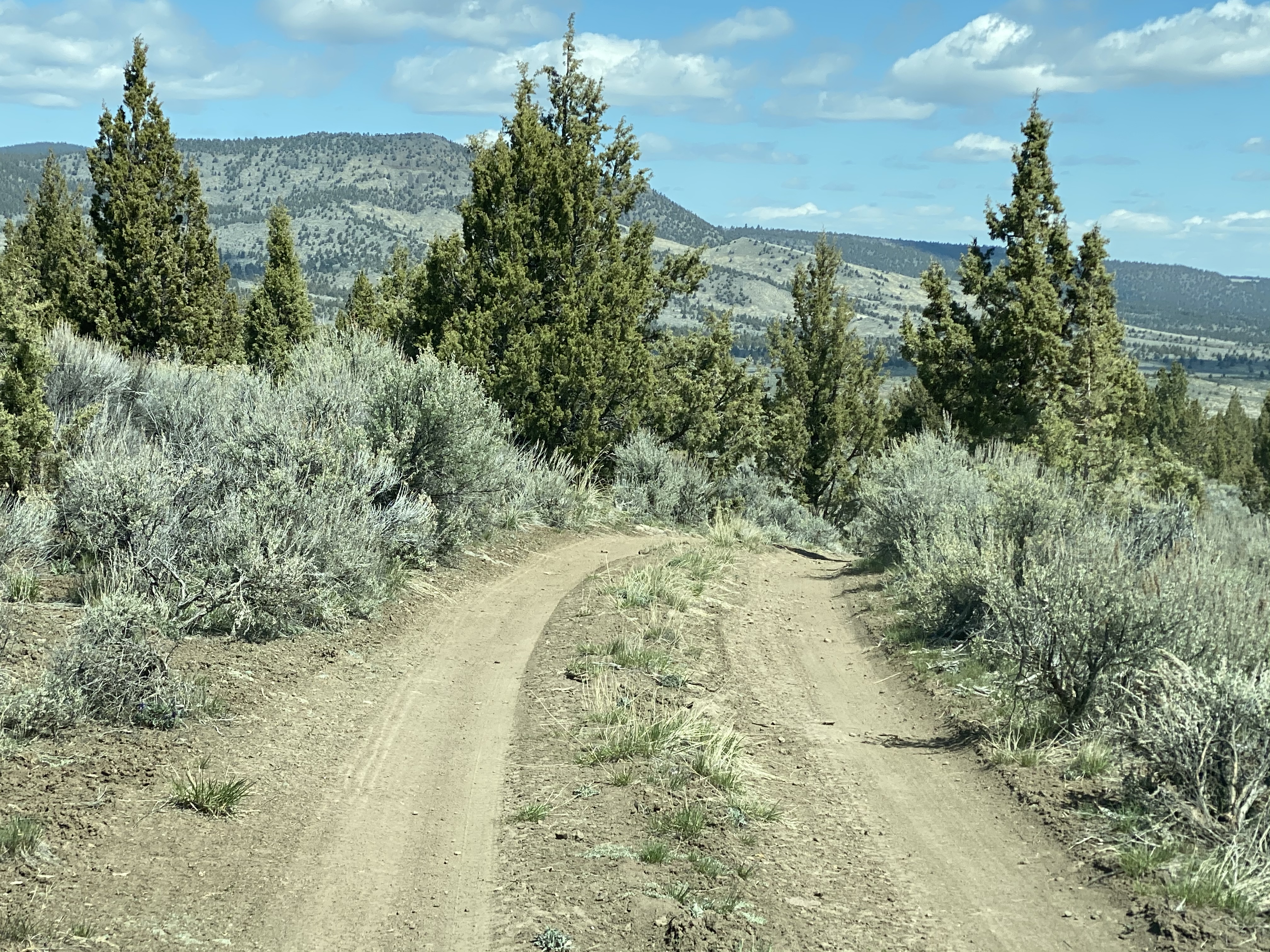|
|
Post by holajonathan on Aug 14, 2021 14:25:07 GMT -5
I bought a bunch of peanut obsidian sight unseen from a Mexican fellow. I got a good price on this somewhat hard to find material, but for some reason I couldn't get photos ahead of time. Not a good sign... Boxes arrived today. I was a little worried at first because the base rock isn't solid black like most peanut obsidian. But it did have some nice big orbs. Here's a 6 or 7 pound chunk: 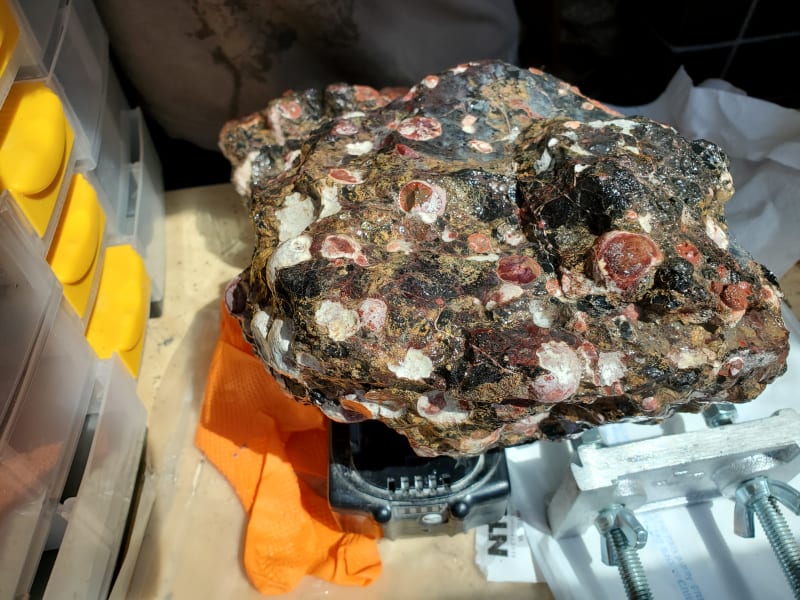 I pulled a few trim saw slices off two chunks... getting excited at this point as I got clean cuts on the trim saw, so I know it's not totally soft and crumbly. 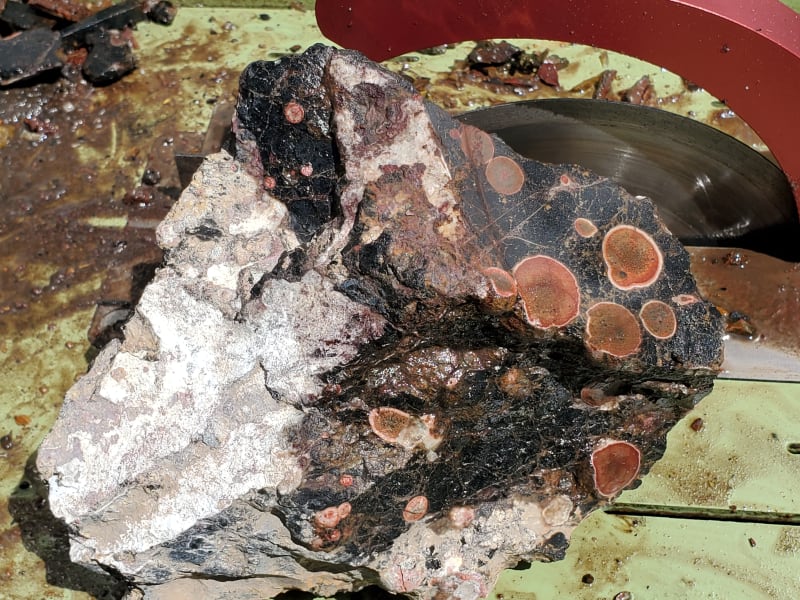 Then I gave it a poor, heavy handed 2 minutes polish on the Genie. 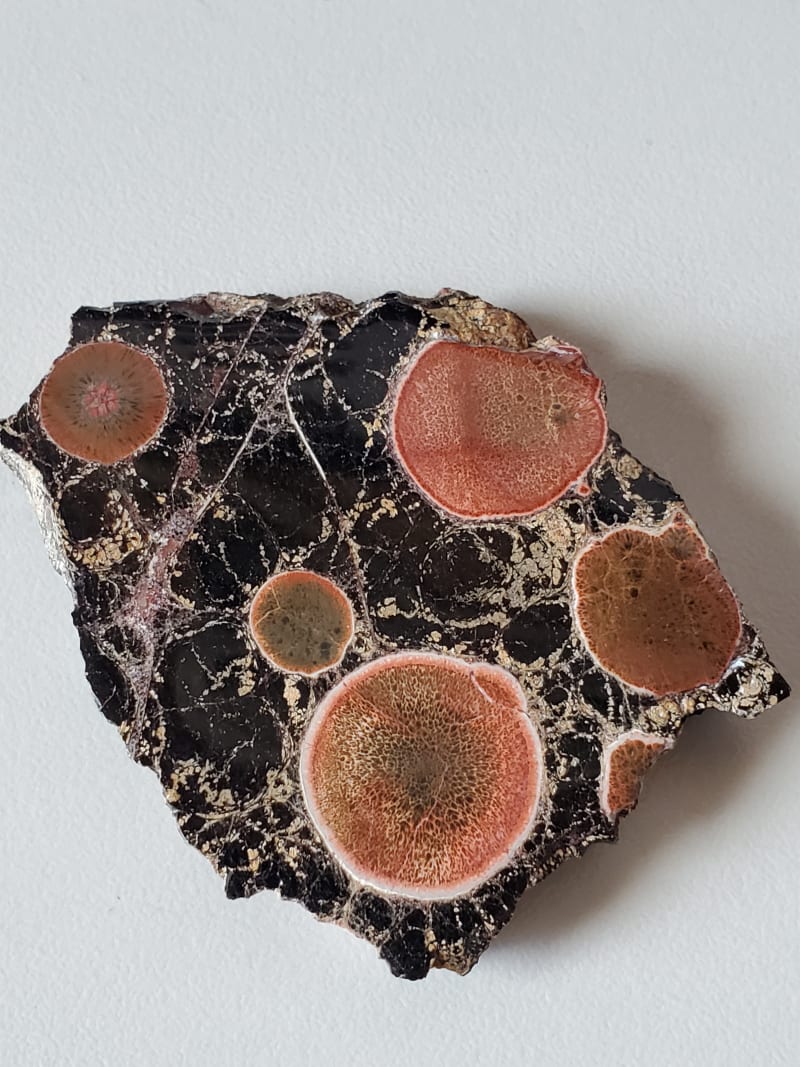 NICE! Slight undercutting on the tan part of the "background" rock but not too bad even on a flat slab that got a heavy handed polish. A light touch and patience should reduce undercutting to a very acceptable level for some gorgeous cabs. Solid despite outward appearance. It passed the bang-it-on-the-table and the try-to-snap-in-half-with-fingers tests. Nice orbs. Some look almost like fine grained dino bone. Orbs do not appear to be chatoyant on this material, but still cool stuff. 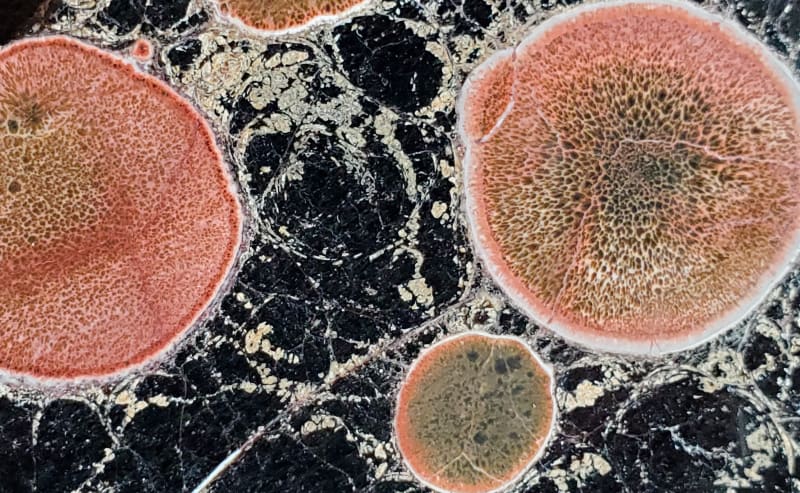 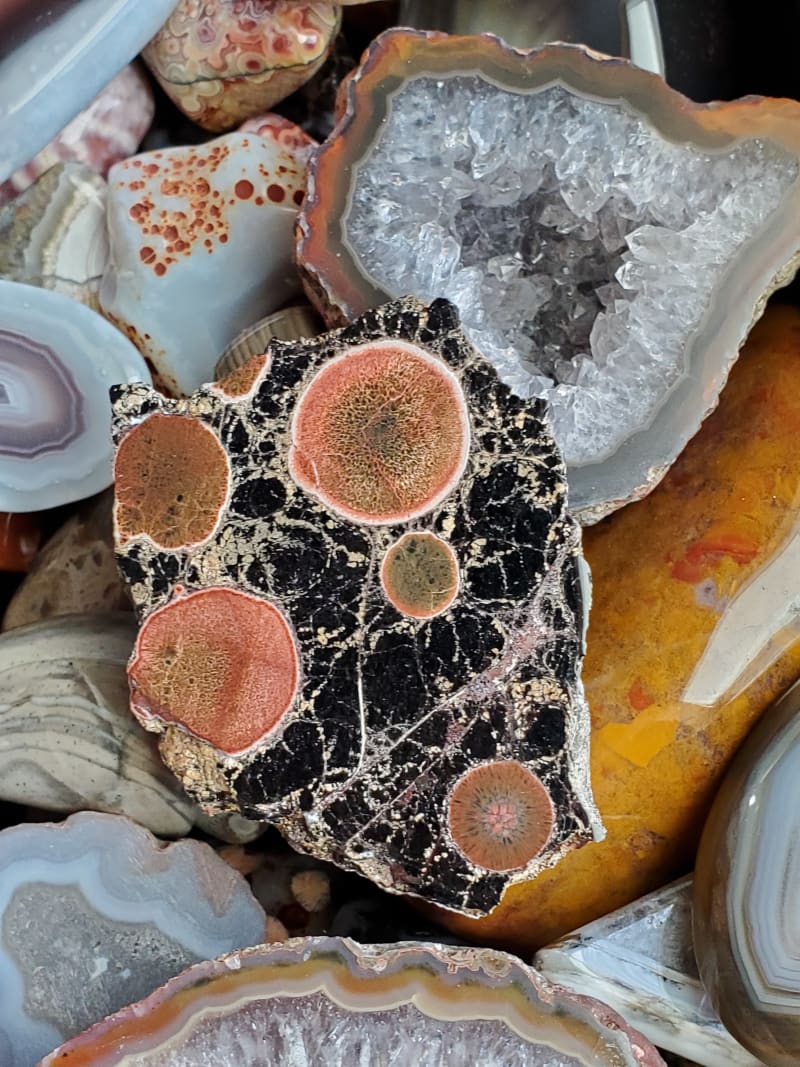 |
|
|
|
Post by fernwood on Aug 14, 2021 18:05:08 GMT -5
Great looking material. Keep posting results.
|
|
|
|
Post by jasoninsd on Aug 14, 2021 18:15:18 GMT -5
Boy, you're not kidding about the orbs resembling dino bone! I really like the patterning in the background rock! Pretty cool!
|
|
|
|
Post by fernwood on Aug 14, 2021 19:04:06 GMT -5
|
|
|
|
Post by holajonathan on Aug 14, 2021 21:26:14 GMT -5
Thanks. I read the article. As it points out, the material isn't actually obsidian, but perlite. And the orbs in the material I have, at least, seem to have a high silica content as they are fairly hard. Almost as hard as agate. The black perlite is more like obsidian but seems to polish easier than obsidian. I've never had success getting any sort of polish on obsidian by just running it through all the Genie wheels quickly. But this has a half-way decent polish doing just that. |
|
JR8675309
freely admits to licking rocks
  
Member since August 2019
Posts: 807
|
Post by JR8675309 on Aug 14, 2021 21:27:09 GMT -5
Wow I am just blown away. This material speaks to me. I've never heard of it until you mentioned it. Please post what you wind up doing with it!
|
|
|
|
Post by MsAli on Aug 14, 2021 21:32:34 GMT -5
Absolutely gorgeous! There was a good article in the Rock & Gem magazine from Russ last month (I think?) Is this from Joseph?
|
|
|
|
Post by holajonathan on Aug 14, 2021 21:34:43 GMT -5
Absolutely gorgeous! There was a good article in the Rock & Gem magazine from Russ last month (I think?) Is this from Joseph? I'll look for the article, thanks. And no. |
|
|
|
Post by stephan on Aug 14, 2021 22:29:25 GMT -5
Thanks. I read the article. As it points out, the material isn't actually obsidian, but perlite. And the orbs in the material I have, at least, seem to have a high silica content as they are fairly hard. Almost as hard as agate. The black perlite is more like obsidian but seems to polish easier than obsidian. I've never had success getting any sort of polish on obsidian by just running it through all the Genie wheels quickly. But this has a half-way decent polish doing just that. Perlite is hydrated (aka finely aged) obsidian, so I see no issues calling it obsidian. Usually it forms a white crust, like what is seen on Apache tears, and can be used to date the material. Now, for something less technical… holy crud, that’s gorgeous. Loving those orbs. you just added another one to the “must have” list. I hope you’re happy.  |
|
|
|
Post by holajonathan on Aug 15, 2021 0:52:07 GMT -5
Thanks. I read the article. As it points out, the material isn't actually obsidian, but perlite. And the orbs in the material I have, at least, seem to have a high silica content as they are fairly hard. Almost as hard as agate. The black perlite is more like obsidian but seems to polish easier than obsidian. I've never had success getting any sort of polish on obsidian by just running it through all the Genie wheels quickly. But this has a half-way decent polish doing just that. Perlite is hydrated (aka finely aged) obsidian, so I see no issues calling it obsidian. Usually it forms a white crust, like what is seen on Apache tears, and can be used to date the material. Now, for something less technical… holy crud, that’s gorgeous. Loving those orbs. you just added another one to the “must have” list. I hope you’re happy.  Many of the pieces do have some white crust on them, so that makes sense. It's not matrix, just a crust, as you say. I guess I can chisel that off and add it to potting soil for my house plants. Aren't the white, gritty, rice size grains in potting soil perlite? |
|
|
|
Post by stephan on Aug 15, 2021 1:05:56 GMT -5
Yes, they are. They’re cooked at high heat (something like 800C) to drive of the water, and then they expand to many times their volume — perlite popcorn.
|
|
|
|
Post by holajonathan on Aug 15, 2021 20:27:41 GMT -5
Yes, they are. They’re cooked at high heat (something like 800C) to drive of the water, and then they expand to many times their volume — perlite popcorn. If I put a chunk in my wood stove would the perlite turn into popcorn, leaving me with with a pile of orbs?  |
|
|
|
Post by stephan on Aug 15, 2021 20:52:33 GMT -5
Yes, they are. They’re cooked at high heat (something like 800C) to drive of the water, and then they expand to many times their volume — perlite popcorn. If I put a chunk in my wood stove would the perlite turn into popcorn, leaving me with with a pile of orbs?  If you have on heck of stove, mybe.  |
|
|
|
Post by holajonathan on Aug 15, 2021 21:20:42 GMT -5
If I put a chunk in my wood stove would the perlite turn into popcorn, leaving me with with a pile of orbs?  If you have on heck of stove, mybe.  As a matter of fact, I do. That video is from my barn. I modified it to basically burn as a gasifier. In other words, I burn the volatile compounds out of the wood in a high heat restricted oxygen environment, without (initially) providing enough oxygen to burn the carbon. Stove top temps hover around 750 degrees F, and my fluke infrared thermometer hits its max reading of 1400 F when pointed at the ceramic glass. This winter I will try this with some scraps and post results here. |
|
|
|
Post by stephan on Aug 15, 2021 21:23:33 GMT -5
If you have on heck of stove, mybe.  As a matter of fact, I do. That video is from my barn. I modified it to basically burn as a gasifier. In other words, I burn the volatile compounds out of the wood in a high heat restricted oxygen environment, without (initially) providing enough oxygen to burn the carbon. Stove top temps hover around 750 degrees F, and my fluke infrared thermometer hits its max reading of 1400 F when pointed at the ceramic glass. This winter I will try this with some scraps and post results here. At the top of the range, that ought to get mighty close. |
|








